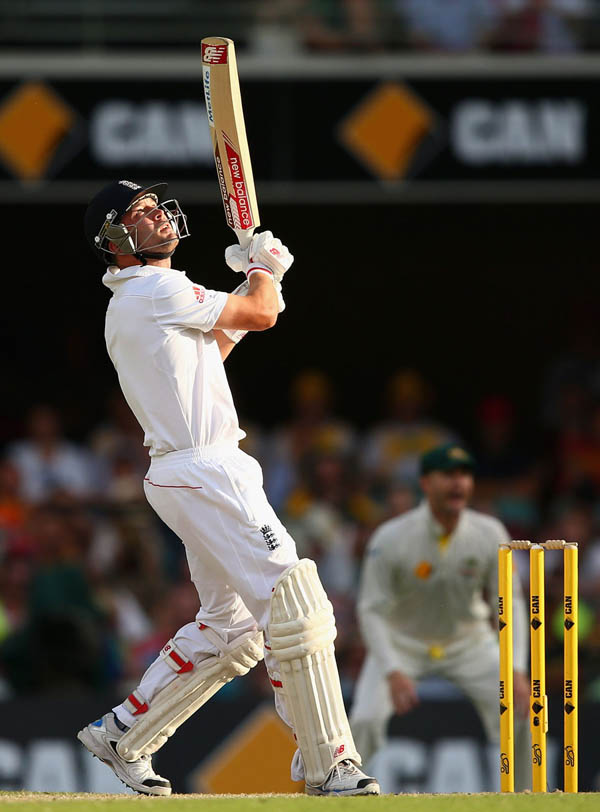Brisbane: During England’s brief first innings at the Gabba, Jonathan Trott tucked a ball from Mitchell Johnson off his legs and, rather than settling for the comfortable single on offer, made a point of pushing for a sharp second run to ensure he stayed on strike.
It was a moment that revealed much about Trott. It was a moment that told the world he was not afraid and that he was not going to avoid the challenge that may well define his career.
But perhaps he protested a little too much. Perhaps that fortitude to ensure he did not duck that challenge went to the heart of Trott’s problem: he is so determined to show he is not afraid of the short ball, that he is getting himself into impossible positions from which to play it.
Consider his approach to facing Johnson. Determined not to be seen to back away or in any way appear tentative, Trott is walking across his stumps and towards the bowler. It is leaving him unbalanced and rendering it more difficult for him to leave the ball or play straight.
Indeed, Trott may well be more nervous of appearing scared than he is by the ball. Like all top batsmen, he would gladly trade some thumping blows to the body rather than losing his wicket.
Certainly the suggestion from David Warner that Trott is “backing away” from the ball will hurt him greatly. “Pretty weak” was Warner’s description of Trott’s second-innings dismissal. “It looks like England have got scared eyes,” he said.
Such words will sting Trott. They will sting far longer and far harsher than any bruise or cut from the ball. For such an allegation goes to the heart of how Trott sees himself. It raises questions not just about his technique, but about his character, his courage and even, in the world of alpha male sportsmen, his masculinity.
It is a misunderstanding, too. Trott’s issue is more technical than it is a fear of the short ball. His technique – his down to up pull stroke, his movement at the moment the ball is released leaving him unbalanced at the crease and his trigger movement that takes him forward – is rendering it hard for him to leave the ball or keep it down.
That is not to say there is not a mental side to this. Trott knows he has an issue and he knows the world is aware of it. In his anxiety, he is becoming ever more frenetic at the crease and failing to follow his own golden rule not to overthink the game. He head, so clear when he batted England to victory on debut at The Oval in 2009 against Johnson et al. or against a brilliant Pakistan attack at Lord’s in 2010 or in Melbourne later the same year, is now clouded by doubt and thought. Trott’s apparent imperturbability has always masked some mental torment. Now it is spilling over.
It is a serious problem. He is struggling to deal with Johnson’s short ball and, unless he can resolve the issue soon, he could be dropped from the Test side for the first time in his career. In both innings of this Test he has fallen to such deliveries, with the dismissal on day three – pulling straight to the man positioned for the stroke at deep-backward square leg – underlining his confusion and unease.
It is a simplification to state that Trott is simply unsettled by the short ball. From the moment he entered Test cricket with that century against Australia, bowlers have tested him that way. The pitches have rarely been this quick but he has prospered on them before and against bowlers of pace. He showed the folly of those who dismissed him after one poor Test in Johannesburg in January 2010.
But Johnson represents a perfect storm of issues for him. Not only is he fast – though no faster than the likes of Tino Best – but he is unpredictable, slingy and left-arm. Trott, unable to anticipate even a rough area in which the ball is directed, is struggling to judge the length or how high the ball will bounce and is unsure whether to defend or attack. At present he is doing a bit of both and a lot of neither.
He could do worse than look how Michael Clarke has risen to the challenge. Clarke, who has also struggled to deal with the short ball from Stuart Broad, responded to his first innings failure with a textbook innings on day three. While he may well have looked to use the pull short earlier in his innings than he might have done on other occasions, he generally went back to basics: he watched the ball carefully, he remained calm and he played straight. Trott, his mind scrambled, is maybe trying to watch the ball, but he is not playing straight and he does not look calm.
He will not suffer for a lack of hard work. After suffering similar problems in the limited-overs series against Australia that ended the English summer (he was only dismissed by Johnson once, with a perfect bouncer, but it stuck in the mind of both men), Trott prepared for this challenge thoroughly. After a brief holiday, he went into the nets and faced a bowling machine cranked up to its maximum setting and aimed at his head and neck for hour after hour. Clearly it was not quite enough to prepare him for the almost unique problems presented by Johnson.
He now stands at a crossroads. How he copes with this challenge will define the rest of his career. But a man good enough to average in excess of 50, as Trott has done in both ODI and Test cricket for much of his career, and a man good enough to win the 2011 ICC Player of the Year award – arguably the highest award in cricket – should not be written off prematurely.

